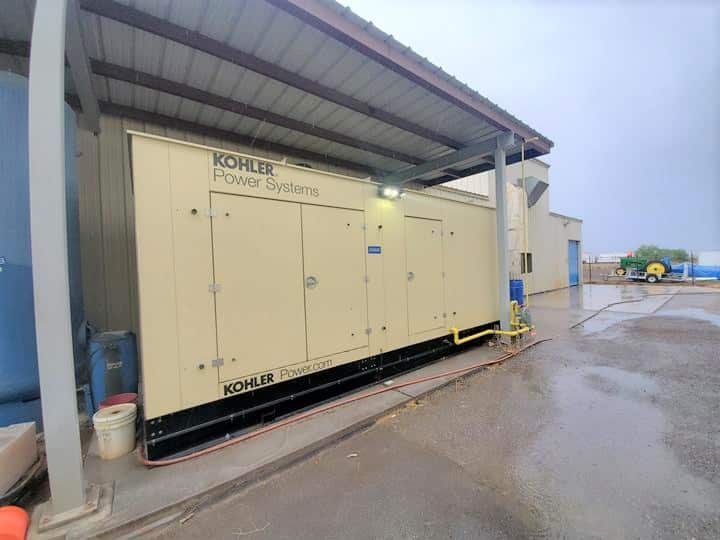Power to Grid Solutions with Natural Gas Generators

There are many reasons natural gas generators are preferred by industry users and those looking to install a backup generator for their business or facility. A few of these reasons may include cleaner burning emissions, lower sound pollution, and one of their biggest selling points – their fuel supply which is connected to the natural gas pipeline versus their diesel counterparts that tend to rely on diesel fuel storage capacity, but one application that is not covered as widely is natural gas generators being used as a solution to help power the grid. One item to note is that setup and operation costs will vary depending on this major factor – whether there is an existing natural gas line already in place or not. If there is already an existing natural gas line in place and ready to go, it means that the application already has natural gas on-site and will be much easier and cheaper during the setup process. If a natural gas line is not available, it will require a little more work and cost to have a natural gas line installed on-site and operational. This includes applications to the natural gas company, any related permits, and the actual installation of the natural gas line.
Using natural gas generators to provide a power to grid solution is certainly a niche application with many barriers to entry, including cost and local state regulation. Most importantly, this solution is mainly viable in a deregulated energy market. A deregulated energy market allows for competing investors to create their own micro grid and generate electricity, which they then participate in selling the electricity produced to retail suppliers (i.e.: the utility company).
While the actual process is challenging, the concept is quite simple. In order to be paid for selling back energy to the utility, you have to be accepted through a Qualified Scheduling Entity (QSE). These QSEs will go over items, such as what type of generator you have, the average load the generator can output, and whether you can have the generator available to provide X kW output at any given time through a parallel interconnect. At Woodstock Power Company, we specialize in this process and work very closely with some of the major players in the industry to ensure a smooth process.
If running the generator in prime rating, you will be compensated for both the prime power output and for the parallel interconnect. The QSE would then schedule you for an X kW block, which you would have your generator run to lower the load from the main utility grid by X amount of kW that your generator can handle. That being said, it is often difficult to get a parallel interconnect, as most utility companies make the process difficult. Due to this reason, we often recommend that you work with a QSE to help handle the process, as well as any bidding that may be involved and can even provide you with alternative options available in your area for this type of application.
As for the equipment, this often varies depending on how much money is being invested into the application and what can be approved for a parallel interconnect. Since there are many generators available with different sizes and ratings for this type of application, we’ll go with a reference sample to help provide a general information that can assist in getting started.
Suppose we go with a 300 kW natural gas generator, which costs around $175,000 brand new. In order to meet the needs for this application, this generator would have to be run in prime configuration with regular service & maintenance to ensure that the generator can be run all the time. It would also require service every 200 hours with the first major service required around 8,000 to 12,000 hours. The average fuel supply line inlet would be 3.0 NPTF with a natural gas fuel supply pressure at 1.74 – 2.74 kPa and a fuel consumption rate of 3161 cfh at 100% load. This would produce an output of 300kwH.
While having a single 300 kW generator can be a clear-cut solution, we often recommend that those investing time and money into this type of application investigate purchasing two 150 kW generator sets and running them in parallel. This ensures that if one generator set goes down, you are still able to maintain 50% of the load. Alternatively, you can configure the two generators to run via a load sharing module. A load sharing module allows for the generators to alternate loads as they’re running. So generator 1 will run for X amount of time, then they will switch and generator 2 will run for X amount of time in a cycle.
With proper maintenance, natural gas generators tend to last longer than diesel generators. We have even seen instances of natural gas generators with 25,000 hours or more still functioning. Average life expectancy of the unit should be up to 25,000 hours but going any further than that could be a cost sink. This is because the engine block is capable of at least 2 full rebuilds, which typically occur around 20,000 – 25,000 hours, but with each rebuild – the engine loses more of its value. Over time, it would make less sense when you compare the cost to replace the generator vs the cost to rebuild the engine and most importantly – a unit loses most of its value after its first major service.
When it comes to using a natural gas generators for power grid solutions, there are many steps involved and many measures that must be taken into account before being able to create a robust working model. If you’re looking into natural gas generators to set up power to grid solutions, reach out to us at Woodstock Power Company! We have industry experts that can help provide consultation, equipment sales, and can guide you through the process.
610-658-3242
Or fill out our Contact Form and our project managers will get back to you shortly!
THE WOODSTOCK POWER COMPANY EXPERIENCE
We have industry experts that focus on commercial generator sets, with in-depth industry knowledge to help you choose the right generator that fits your needs.
We are industry leaders in buying and selling used generators to fit the needs of many businesses, including commercial, industrial, medical, agricultural, and university. This includes facilities like hospitals, better living centers, nursing home, airports, hotels, resorts, restaurants, retail centers, manufacturing, production, and more.
Our experts are ready to assist you from answering any questions you may have about power generator sets to helping you find the best selection in our inventory based on:
- Peak & Average Power Requirements
- Fuel Preference (Natural Gas or Diesel)
- Portability & Stationary Power
- Prime & Standby Generator Requirements
- Available Space & Exhaust Restrictions
We carry only the most top rated new, used, and surplus power generator sets for sale, providing you with a great value generator that will fit your budget.
Our generators have been thoroughly inspected, serviced, and verified, which ensures that you will be buying a quality generator that you can depend on. If a generator is not up to par with industry standards, we make all necessary repairs or modifications, and fully test every generator before we sell. This ensures a full turnkey generator that’s ready to fire up and go!
Due to our wide selection of generator sets, we’re confident that we can find the model that best suits your operational needs and budget.
We also buy used generators in good quality, if you have already upgraded and you’re looking to sell your older model.
Feel free to contact us with any questions, concerns, or inquiries to learn more about the Woodstock Power Company experience and the quality level of products & services we provide.

